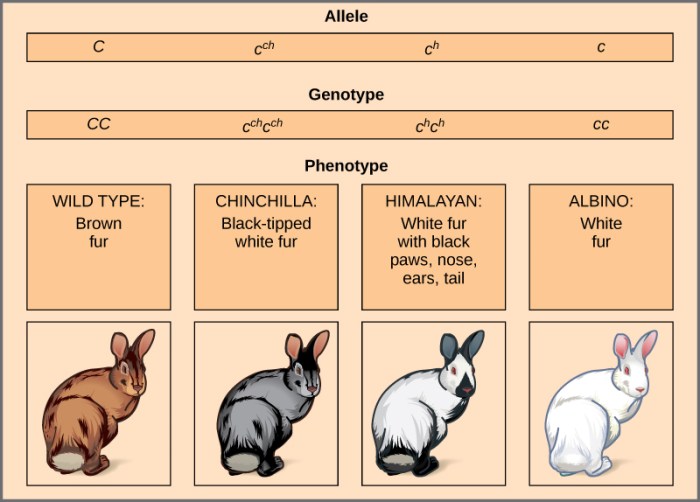Delve into the fascinating world of albinism with our comprehensive guide, “Albinism from Genotype to Phenotype Answer Key.” This detailed exploration unravels the genetic underpinnings, clinical manifestations, and management strategies of this unique condition, shedding light on its complexities and empowering individuals affected by it.
Unveiling the relationship between genotype and phenotype in albinism, we delve into the molecular mechanisms that govern skin pigmentation and unravel the genetic defects responsible for this condition. By examining the clinical manifestations, we explore the impact of albinism on vision, skin, hair, and other sensory functions.
Albinism: An Overview

Albinism is a group of inherited conditions characterized by the complete or partial absence of the pigment melanin, resulting in a lack of color in the skin, hair, and eyes. The genetic basis of albinism lies in mutations in genes involved in melanin synthesis.
There are several types of albinism, each with distinct genetic and phenotypic characteristics.
Genotype and Phenotype in Albinism
The genotype of an individual with albinism refers to the specific combination of alleles at the genes responsible for melanin production. The phenotype, on the other hand, encompasses the observable characteristics of albinism, such as skin, hair, and eye color.
Mutations in different genes can lead to different types of albinism, resulting in varying degrees of melanin deficiency. For instance, mutations in the OCA2 gene cause oculocutaneous albinism type II, characterized by complete absence of melanin in the skin, hair, and eyes, while mutations in the SLC45A2 gene lead to oculocutaneous albinism type IV, which results in partial melanin deficiency.
Molecular Basis of Albinism
Melanin is synthesized in specialized cells called melanocytes. The molecular basis of albinism involves defects in genes that encode proteins involved in melanin production, such as tyrosinase, tyrosinase-related protein 1 (TYRP1), and oculocutaneous albinism II (OCA2) protein. These genetic defects disrupt the production or distribution of melanin, leading to the characteristic lack of pigmentation in individuals with albinism.
Clinical Manifestations of Albinism
The clinical manifestations of albinism primarily involve abnormalities in skin, hair, and eye pigmentation. Skin is typically pale or white, hair is often white or yellow, and eyes are typically blue or light gray. Vision is often impaired due to the lack of melanin in the eyes, resulting in reduced visual acuity, nystagmus (involuntary eye movements), and photophobia (sensitivity to light).
Other potential complications associated with albinism include skin cancer, hearing loss, and immune system deficiencies.
Management and Treatment of Albinism, Albinism from genotype to phenotype answer key
There is currently no cure for albinism. Management and treatment focus on mitigating the effects of the condition and improving quality of life. This includes using sunscreens and protective clothing to prevent skin damage, using assistive devices such as magnifiers and low-vision aids to improve vision, and providing genetic counseling and support groups for individuals with albinism and their families.
Research and Future Directions in Albinism
Ongoing research in albinism aims to gain a better understanding of the genetic and molecular mechanisms underlying the condition, as well as to develop new therapies. Potential future directions for research include gene therapy to correct the genetic defects responsible for albinism and stem cell treatments to restore melanin production.
Question & Answer Hub: Albinism From Genotype To Phenotype Answer Key
What is the genetic basis of albinism?
Albinism is caused by mutations in genes involved in the production of melanin, the pigment responsible for skin, hair, and eye color.
How does albinism affect vision?
Albinism can cause a range of vision problems, including reduced visual acuity, nystagmus (involuntary eye movements), and photophobia (sensitivity to light).
What are the different types of albinism?
There are several types of albinism, each with its own unique genetic cause and clinical manifestations.
What are the current treatment options for albinism?
Treatment for albinism focuses on managing its symptoms, such as sun protection, low vision aids, and genetic counseling.

